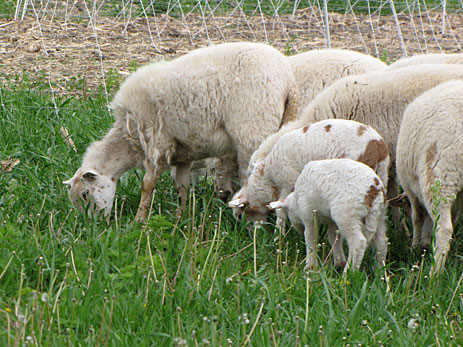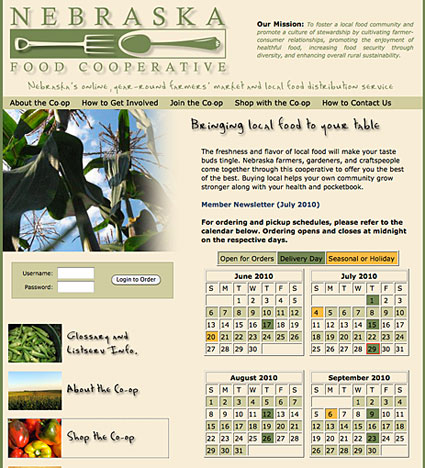 Some of these lambs are all grown up and ready to become chops. Photo: Steph LarsenRight now, I’m facing a problem shared by scores of farmers — beginning and experienced — across the country. I have four lambs that have been raised entirely on grass, and I know there are customers eager to buy them.
Some of these lambs are all grown up and ready to become chops. Photo: Steph LarsenRight now, I’m facing a problem shared by scores of farmers — beginning and experienced — across the country. I have four lambs that have been raised entirely on grass, and I know there are customers eager to buy them.
I just don’t know who they are.
The irony of selling directly to consumers is that while farmers gain the largest share of the food dollar this way, it also forces them to be marketers — something they may not have the skills, let alone the time, to be successful.
As I’ve said before, I don’t yet consider myself a farmer, but I’ll use myself as an example anyway. I have a demanding full-time job that I love, and I often spend my evenings and weekends tending to and experimenting with the things we’re growing. Someday we’ll get to the point where we have enough products to start selling them in addition to eating them. But will we have time to grow them and spend so many hours a week trying to find customers for them?
There is another way.
Nebraska, where I live, has an online, statewide farmers’ market modeled after the successful and innovative Oklahoma Food Co-op. Both create a central location for producers and consumers to find each other. The original idea was the brainchild of Robert Waldrop, who still serves as the president of the Oklahoma Food Co-op. From the looks of their website, they, like many food co-ops, rely on their board and volunteers to keep things running smoothly. Our Nebraska version, on the other hand, does employ at least one person part time.
 The Nebraska Food Co-op website is a pretty slick online marketplace for local food. Once or twice a month depending on the season, the dozens of producer members of the Nebraska Food Co-op go online and list what products they have available and in what quantities. This time of year, it’s bursting with all the fresh veggies that make summer so grand. There’s always a wide variety of meat available, this being Nebraska, and I can find eggs, home-canned goods, natural beauty products, and honey year-round. There’s even an organic miller that provides me with breakfast cereal, whole-wheat flour, hulled barley, and other grain products I’ve never heard of.
The Nebraska Food Co-op website is a pretty slick online marketplace for local food. Once or twice a month depending on the season, the dozens of producer members of the Nebraska Food Co-op go online and list what products they have available and in what quantities. This time of year, it’s bursting with all the fresh veggies that make summer so grand. There’s always a wide variety of meat available, this being Nebraska, and I can find eggs, home-canned goods, natural beauty products, and honey year-round. There’s even an organic miller that provides me with breakfast cereal, whole-wheat flour, hulled barley, and other grain products I’ve never heard of.
Consumer members, who pay an annual membership fee, have a set period of time to shop, selecting a “drop site” where they’ll pick up their order. The inventory decreases in real time, so when that last bunch of Swiss chard is gone, it’s gone. On the appointed day, producers relay their products in to a central location, via drop points, where orders are put together and sent back out to the drop points. When my order gets to me, every item has my name, the farm it came from, and what’s inside the brown paper or plastic package.
I’ve been a member of the Co-op for 2 years, so I’ve gotten to know the consumer side of the operation. It gives me access to things I wouldn’t have heard about otherwise, with the convenient bonus of not having to travel to each one individually. Our drop point is a small family farm about 7 miles from my office. They have freezer space for the meat we order, and I always have a nice chat with the farmers as I write out the check. The added bonus is that I can pick up the raw milk that the farmer produces at the same time, which can’t be sold through the co-op because in Nebraska, raw milk must be sold on-farm.
Now that I’m also a producer, this method offers a lot of advantages for someone like me. The first is time: I don’t have to commit to being at a market stall several hours a week for the duration of the growing season, and thanks to the relayed distribution system, I don’t even have to drive that far. The second is scale — because the entry cost is low, I can start with putting just a few items up to test the market and grow from there.
And of course, because someone else is responsible for the marketing, it leaves me a lot more time to do things like contemplate a high tunnel to extend my growing season. The co-op prints and distributes promotional materials, plus members spread the word: based on the steadily increasing number of products in the last few years, it seems to be working. Consumers still can build a relationship with the producers they buy from by reading the profiles of each producer, which detail their individual practices and philosophy.
Other states and regions are starting to use similar online farmers market models, or create even bigger-scale ones like Ecotrust’s Foodhub. The Oklahoma Food Co-op does their best to help by providing their software free and sharing a long list of lessons they’ve learned.
As a producer, the Nebraska Food Co-op will give me an opportunity to experiment with things and expand my production slowly. Unfortunately, it can’t help me sell my lambs, because I don’t plan to use a USDA-inspected slaughterhouse when it’s time for them to become chops.
In this case, then. I’ll have to do my own marketing pitch. So, dear readers: If you know anyone who wants to buy a grassfed lamb “on the hoof,” so to speak — send them my way.



